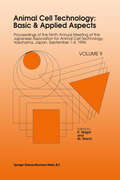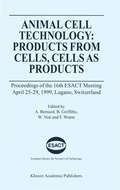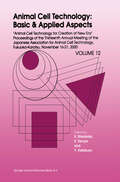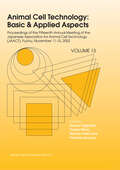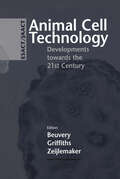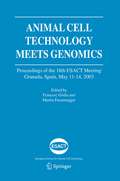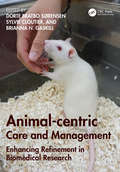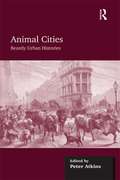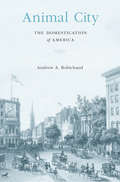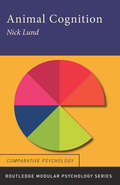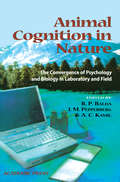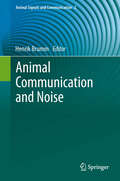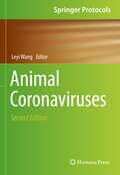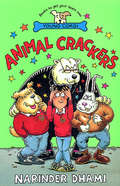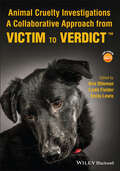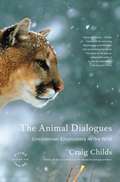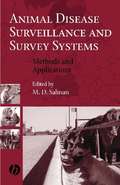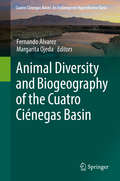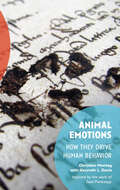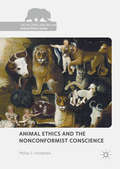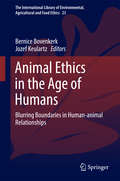- Table View
- List View
Animal Cell Technology: Proceedings of the Ninth Annual Meeting of the Japanese Association for Animal Cell Technology, Yokohama, Japan, September 1–4, 1996 (Animal Cell Technology: Basic & Applied Aspects #9)
by K. Nagai M. WachiAnimal cell technology is a growing discipline of cell biology which aims not only to understand structures, functions and behaviors of differentiated animal cells but also to uncover their abilities for industrial and medical purposes. The goal of animal cell technology includes clonal expansion of differentiated cells with useful abilities, optimization of their culture conditions on the industrial scale, modulation of their ability in order efficiently to produce medically and pharmaceutically important proteins, and application of animal cells to gene therapy and formation of artificial organs. This Volume gives the readers a complete review of the present state of the art in Japan, a country where this field is well advanced, as well as in Asia, Europe and the United States. The Proceedings will be useful for cell biologists, biochemists, molecular biologists, biochemical engineers and those in other disciplines related to animal cell culture, working in academic environments as well as in the biotechnology and pharmaceutical industries.
Animal Cell Technology: Proceedings of the 16th ESACT Meeting April 25–29, 1999, Lugano, Switzerland
by Wolfgang Noé Florian Wurm Alain Bernard Bryan GriffithsProceedings of the 16th ESACT Meeting, April 25-29, 1999, Lugano, Switzerland
Animal Cell Technology: Proceedings of the Thirteenth Annual Meeting of the Japanese Association for Animal Cell Technology (JAACT), Fukuoka-Karatsu, November 16–21, 2000 (Animal Cell Technology: Basic & Applied Aspects #12)
by Sanetaka Shirahata Kiichiro Teruya Yoshinori KatakuraAnimal cell technology is a growing discipline of cell biology, which aims not only to understand structures, functions, and behaviours of differentiated animal cells but also to ascertain their ability to be used for industrial and medical purposes. The goal of animal cell technology includes accomplishments of clonal expansion of differentiated cells with useful ability, optimisation of their culture conditions, modulation of their ability for production of medically and pharmaceutically important proteins, and the application of animal cells to gene therapy, artificial organs, and functional foods. This volume gives the reader a complete review of the present state of the art in Japan and other countries where this field is well advanced. The Proceedings will be useful for cell biologists, biochemists, molecular biologists, immunologists, biochemical engineers, and other disciplines related to animal cell culture, working in either academic environments or in industries of biotechnology and pharmacy.
Animal Cell Technology: Proceedings of the Fifteenth Annual Meeting of the Japanese Association for Animal Cell Technology (JAACT), Fuchu, Japan, November 11-15, 2002 (Animal Cell Technology: Basic & Applied Aspects #13)
by Kazumi Yagasaki Yutaka Miura Makoto Hatori Yoshihiro NomuraAnimal cell technology is a growing discipline of cell biology which aims not only to understand structures, functions and behaviors of differentiated animal cells, but also to ascertain their abilities to be used in industrial and medical purposes. The goal of animal cell technology includes accomplishments of clonal expansion of differentiated cells with useful ability, optimization of their culture conditions, modulation of their ability for production of medically and pharmaceutically important proteins and the application of animal cells to gene therapy, artificial organs and functional foods. This volume gives the readers a complete review of present state-of-the-art in Japan and other countries where this field is well advanced. The Proceedings will be useful for the cell biologists, biochemists, molecular biologists, immunologists, biochemical engineers and other disciplines related to animal cell culture, working in either academic environments or in industries of biotechnology and pharmacy.
Animal Cell Technology: Developments towards the 21st Century
by E. C. Beuvery W. P. Zeijlemaker J. B. GriffithsAnimal cell technology is a discipline of growing importance, which aims not merely at understanding structure, function and behaviour of differentiated animal cells, but especially at the development of their abilities useful for clinical application. Topics of interest in this regard include: viral vaccines, pharmaceutical proteins and novel applications such as gene therapy and organ culture. Undoubtedly, these Proceedings of the joint Meeting of the European Society for Animal Cell Technology and the Japanese Association for Animal Cell Technology (Veldhoven, The Netherlands, September 1994) review the most recent status of the field, and will be most valuable to anyone actively involved in the culture of animal cells and its applications. The contributions to this volume were strictly selected on the basis of quality and novelty of contents. Kluwer is honoured to be able to add this work to its strongly developing publication programme in cell and tissue culture, which now has its connections to all major Societies in this field worldwide. Audience: Cell biologists, biochemists, molecular biologists, immunologists, virologists and all other disciplines related to animal cell technology, working in an academic environment, as well as in (biotechnology or pharmaceutical) industry.
Animal Cell Technology Meets Genomics: Proceedings of the 18th ESACT Meeting. Granada, Spain, May 11-14, 2003 (ESACT Proceedings #2)
by Francesc Gòdia Martin M. FusseneggerThe 18th ESACT meeting was celebrated in Granada (Spain) in May 2003, and was entitled "Animal Cell Technology Meets Genomics", in order to reflect that the emerging technologies in the area of genomics, proteomics and other "-omics"-type disciplines will provide key technological assets to increase knowledge and open new horizons in animal cell technology. During the meeting a variety of top-class emerging technologies were presented together with the lastest advances in more mature industrial areas. The meeting was opened by a first session devoted to the understanding of basic cellular mechanisms, and four sessions focused on applied aspects of animal cell technology: Cell-based therapies and gene-based therapies, target discovery and biopharmaceuticals. The Granada Meeting has also seen a special focus on forefront industrial case studies. The spirit and scientific excellence of the 18th ESACT meeting is now reflected in different chapters of the book. The book presents, in form of short papers, a high number of the contributions to the meeting, and has been prepared with the aim to provide a relevant reference of the current research efforts in Animal Cell Technology.
Animal-centric Care and Management: Enhancing Refinement in Biomedical Research
by Dorte Bratbo Sørensen, Sylvie Cloutier, and Brianna N. GaskillThe concept of the 3Rs (Refinement, Reduction and Replacement) has been used as a framework for improving the welfare of laboratory animals for the last half century. By establishing an animal-centric view on housing and management, Animal-centric Care and Management: Enhancing Refinement in Biomedical Research takes Russell and Burch’s definition of Refinement as "elimination of inhumanities" and goes further. Rather than fitting animals into experimental conditions, it encourages readers to adjust conditions to better meet the behavioral, emotional, physical, and physiological needs and preferences of the animals. The team of expert authors, from the fields of laboratory animal science, ethology, biology as well as animal training, provide ideas for creating housing conditions and handling procedures that induce, to the best of current abilities and knowledge, a long-term positive state of mind in the animals under our care. This book is written for animal caretakers, animal health technicians, researchers, animal facility managers, laboratory animal veterinarians, and anyone who engages in work with living experimental animals or is interested in the continuous improvement of laboratory animal welfare. This interdisciplinary guide will act as a catalyst, resulting in multiple viewpoints and fields collaborating to optimize laboratory animal welfare.
Animal-centric Care and Management: Enhancing Refinement in Biomedical Research
by Dorte Bratbo Sørensen Sylvie Cloutier Brianna N. GaskillThe concept of the 3Rs (Refinement, Reduction and Replacement) has been used as a framework for improving the welfare of laboratory animals for the last half century. By establishing an animal-centric view on housing and management, Animal-centric Care and Management: Enhancing Refinement in Biomedical Research takes Russell and Burch’s definition of Refinement as "elimination of inhumanities" and goes further. Rather than fitting animals into experimental conditions, it encourages readers to adjust conditions to better meet the behavioral, emotional, physical, and physiological needs and preferences of the animals. The team of expert authors, from the fields of laboratory animal science, ethology, biology as well as animal training, provide ideas for creating housing conditions and handling procedures that induce, to the best of current abilities and knowledge, a long-term positive state of mind in the animals under our care. This book is written for animal caretakers, animal health technicians, researchers, animal facility managers, laboratory animal veterinarians, and anyone who engages in work with living experimental animals or is interested in the continuous improvement of laboratory animal welfare. This interdisciplinary guide will act as a catalyst, resulting in multiple viewpoints and fields collaborating to optimize laboratory animal welfare.
Animal Cities: Beastly Urban Histories
by Peter AtkinsAnimal Cities builds upon a recent surge of interest about animals in the urban context. Considering animals in urban settings is now a firmly established area of study and this book presents a number of valuable case studies that illustrate some of the perspectives that may be adopted. Having an ’urban history’ flavour, the book follows a fourfold agenda. First, the opening chapters look at working and productive animals that lived and died in nineteenth-century cities such as London, Edinburgh and Paris. The argument here is that their presence yields insights into evolving understandings of the category ’urban’ and what made a good city. Second, there is a consideration of nineteenth-century animal spectacles, which influenced contemporary interpretations of the urban experience. Third, the theme of contested animal spaces in the city is explored further with regard to backyard chickens in suburban Australia. Finally, there is discussion of the problem of the public companion animal and its role in changing attitudes to public space, illustrated with a chapter on dog-walking in Victorian and Edwardian London. Animal Cities makes a significant contribution to animal studies and is of interest to historical geographers, urban, cultural, social and economic historians and historians of policy and planning.
Animal Cities: Beastly Urban Histories
by Peter AtkinsAnimal Cities builds upon a recent surge of interest about animals in the urban context. Considering animals in urban settings is now a firmly established area of study and this book presents a number of valuable case studies that illustrate some of the perspectives that may be adopted. Having an ’urban history’ flavour, the book follows a fourfold agenda. First, the opening chapters look at working and productive animals that lived and died in nineteenth-century cities such as London, Edinburgh and Paris. The argument here is that their presence yields insights into evolving understandings of the category ’urban’ and what made a good city. Second, there is a consideration of nineteenth-century animal spectacles, which influenced contemporary interpretations of the urban experience. Third, the theme of contested animal spaces in the city is explored further with regard to backyard chickens in suburban Australia. Finally, there is discussion of the problem of the public companion animal and its role in changing attitudes to public space, illustrated with a chapter on dog-walking in Victorian and Edwardian London. Animal Cities makes a significant contribution to animal studies and is of interest to historical geographers, urban, cultural, social and economic historians and historians of policy and planning.
Animal City: The Domestication of America
by Andrew A. RobichaudAmerican urbanites once lived alongside livestock and beasts of burden. But as cities grew, human–animal relationships changed. The city became a place for pets, not slaughterhouses or working animals. Andrew Robichaud traces the far-reaching consequences of this shift—for urban landscapes, animal- and child-welfare laws, and environmental justice.
Animal Cognition (Routledge Modular Psychology)
by Nick LundAnimal Cognition looks at how non-human animals process information from their environment. Nick Lund has written an accessible and engaging account of this area of comparative psychology. The book contains chapters on animal navigation (including homing behaviour and migration), animal communication methods and research into animal language, and attempts to teach language to non-human animals. A chapter on memory includes models of memory in non-human animals and discusses the importance of memory in navigation and foraging behaviour.Animal Cognition is designed to cover the AQA(A) A2 level specification but will also be of interest to undergraduates new to comparative psychology. It is well illustrated and includes a study aids section with examination questions and answers, and key research summaries.
Animal Cognition (Routledge Modular Psychology)
by Nick LundAnimal Cognition looks at how non-human animals process information from their environment. Nick Lund has written an accessible and engaging account of this area of comparative psychology. The book contains chapters on animal navigation (including homing behaviour and migration), animal communication methods and research into animal language, and attempts to teach language to non-human animals. A chapter on memory includes models of memory in non-human animals and discusses the importance of memory in navigation and foraging behaviour.Animal Cognition is designed to cover the AQA(A) A2 level specification but will also be of interest to undergraduates new to comparative psychology. It is well illustrated and includes a study aids section with examination questions and answers, and key research summaries.
Animal Cognition in Nature: The Convergence of Psychology and Biology in Laboratory and Field
by Russell P. Balda Irene M. Pepperberg A. C. KamilIn this book, the editors bring together results from studies on all kinds of animals to show how thinking on many behaviors as truly cognitive processes can help us to understand the biology involved. Taking ideas and observations from the while range of research into animal behavior leads to unexpected and stimulating ideas. A space is created where the work of field ecologists, evolutionary ecologists and experimental psychologists can interact and contribute to a greater understanding of complex animal behavior, and to the development of a new and coherent field of study.
Animal Communication and Noise (Animal Signals and Communication #2)
by Henrik BrummThe study of animal communication has led to significant progress in our general understanding of motor and sensory systems, evolution, and speciation. However, one often neglected aspect is that signal exchange in every modality is constrained by noise, be it in the transmission channel or in the nervous system. This book analyses whether and how animals can cope with such constraints, and explores the implications that noise has for our understanding of animal communication. It is written by leading biologists working on different taxa including insects, fish, amphibians, lizards, birds, and mammals. In addition to this broad taxonomic approach, the chapters also cover a wide array of research disciplines: from the mechanisms of signal production and perception, to the behavioural ecology of signalling, the evolution of animal communication, and conservation issues. This volume promotes the integration of the knowledge gained by the diverse approaches to the study of animal communication and, at the same time, highlights particularly interesting fields of current and future research.
Animal Coronaviruses (Springer Protocols Handbooks)
by Leyi WangThis detailed new edition compiles fully updated practical methodologies and approaches for diagnosticians and researchers working toward a better understanding of animal coronaviruses. The book explores vital techniques in virus isolation, diagnostic approaches via the detection of viral nucleic acids or proteins, serology, disease-targeted animal species models, and next-generation sequencing and bioinformatics. Written for the invaluable Springer Protocols Handbooks series, chapters contain readily reproducible laboratory protocols as well as expert tips on troubleshooting and avoiding known pitfalls. Thorough and hands-on, Animal Coronaviruses, Second Edition will help readers design and carry out their increasingly important projects in clinical research, diagnostics, disease surveillance, and epidemiological study involving this family of viruses.
Animal Crackers
by Narinder DhamiWhen Sanjay gets a bump on his head from the school bully, he wakes up to find that everyone in the playground has turned into an animal! The headmaster's a polar bear and Sanjay's best friend is a sheepdog. Even the ambulance that comes to take him to hospital is driven by a gorilla and the paramedic is a penguin...Seeing his schoolmates in a new light gives Sanjay a clever idea about how to defeat the bully... Will Sanjay's wily plan work, or has the whole world gone animal crackers?
Animal Cruelty Investigations: A Collaborative Approach from Victim to Verdict
by Kris K. Otteman Brant Linda Fielder Emily LewisAnimal Cruelty Investigations: A Collaborative Approach from Victim to Verdict provides a framework for the experts who respond to animal cruelty cases: veterinarians, law enforcement agencies, animal care and control organizations, and prosecutors. This book is a practical guide which provides insight and direction for every phase of an animal cruelty investigation. The step-by-step guidance on responding to particular issues and challenges related to animal cruelty cases is bolstered by the extensive library of checklists, form templates, specific case protocols, and lists of available resources. This book is designed to empower readers to respond to animal cruelty cases confidently and effectively by: Introducing veterinarians to their critical role in animal cruelty investigations including forensic examination and necropsy, crime scene response, report writing, and testimony. Included are detailed Specific Case Protocols for common animal cruelty scenarios. Helping animal shelters navigate the challenges of holding animals in protective custody, housing unusual species, and placing evidence animals in foster care. Offering law enforcement agencies useful methods for investigating animal cruelty such as search and seizure protocols, witness interview techniques, and valuable forms and templates necessary to strengthen and ensure proper search warrant execution, evidence collection and handling, and chain of custody; all with a focus on animals as both victims and evidence. Guiding prosecutors through the steps necessary to utilize the veterinarian’s findings during trial and providing insight into issues to be considered when reviewing search warrants, filing charges, proposing plea agreements, or filing pre-conviction forfeiture motions. This book is a must-have reference and guide for veterinarians, technicians, law enforcement officers, prosecutors, and all those involved in the protection of animals’ health and wellbeing. The successful investigation of animal crimes relies on each of these disciplines, not only carrying out their professional duties, but having a collective understanding of what each other needs in order to meet that expectation.
Animal Cruelty Investigations: A Collaborative Approach from Victim to Verdict
by Kris Otteman Linda Fielder Emily LewisAnimal Cruelty Investigations: A Collaborative Approach from Victim to Verdict provides a framework for the experts who respond to animal cruelty cases: veterinarians, law enforcement agencies, animal care and control organizations, and prosecutors. This book is a practical guide which provides insight and direction for every phase of an animal cruelty investigation. The step-by-step guidance on responding to particular issues and challenges related to animal cruelty cases is bolstered by the extensive library of checklists, form templates, specific case protocols, and lists of available resources. This book is designed to empower readers to respond to animal cruelty cases confidently and effectively by: Introducing veterinarians to their critical role in animal cruelty investigations including forensic examination and necropsy, crime scene response, report writing, and testimony. Included are detailed Specific Case Protocols for common animal cruelty scenarios. Helping animal shelters navigate the challenges of holding animals in protective custody, housing unusual species, and placing evidence animals in foster care. Offering law enforcement agencies useful methods for investigating animal cruelty such as search and seizure protocols, witness interview techniques, and valuable forms and templates necessary to strengthen and ensure proper search warrant execution, evidence collection and handling, and chain of custody; all with a focus on animals as both victims and evidence. Guiding prosecutors through the steps necessary to utilize the veterinarian’s findings during trial and providing insight into issues to be considered when reviewing search warrants, filing charges, proposing plea agreements, or filing pre-conviction forfeiture motions. This book is a must-have reference and guide for veterinarians, technicians, law enforcement officers, prosecutors, and all those involved in the protection of animals’ health and wellbeing. The successful investigation of animal crimes relies on each of these disciplines, not only carrying out their professional duties, but having a collective understanding of what each other needs in order to meet that expectation.
The Animal Dialogues: Uncommon Encounters in the Wild
by Craig ChildsFrom one of the finest nature writers at work in America today-a lyrical, dramatic, illuminating tour of the hidden domain of wild animals. Whether recalling the experience of being chased through the Grand Canyon by a bighorn sheep, swimming with sharks off the coast of British Columbia, watching a peregrine falcon perform acrobatic stunts at 200 miles per hour, or engaging in a tense face-off with a mountain lion near a desert waterhole, Craig Childs captures the moment so vividly that he puts the reader in his boots. Each of the forty brief, compelling narratives in The Animal Dialogs focuses on the author's own encounter with a particular species and is replete with astonishing facts about the species' behavior, habitat, breeding, and lifespan. But the glory of each essay lies in Childs's ability to portray the sometimes brutal beauty of the wilderness, to capture the individual essence of wild creatures, to transport the reader beyond the human realm and deep inside the animal kingdom
Animal Disease Surveillance and Survey Systems: Methods and Applications
by M. D. SalmanThis valuable text presents methods and techniques for conducting an animal disease surveillance program, and developing an animal health moitoring system. The text is a 'recipe book' for these techniques as it explains modern techniques, while emphasizing the fundamentals and principles of using these techniques.The book is targeted to epidemiologists and other animal health authorities who are working in national, regional, and international programs. The book can be used as a text for professional and postgraduate training curricula. This text will be of value in veterinary epidemiology and regulatory medicine, where there is need for a concise collection of material on animal disease monitoring, surveillance, and reporting strategies. This need arises from a new era of international trade regulations based on animal diseases, new demands for accountability in utilization of research funds, and calls for prioritizing and economically justifying animal health regulatory and diagnostic activities.
Animal Diversity and Biogeography of the Cuatro Ciénegas Basin (Cuatro Ciénegas Basin: An Endangered Hyperdiverse Oasis)
by Fernando Álvarez Margarita OjedaThis volume investigates the contemporary fauna that inhabit the Cuatro Ciénegas Basin. Divided into 15 chapters, it addresses and describes their diversity, taxonomic and biogeogaphic affinities, and ecological characteristics. The Cuatro Ciénegas Valley is a unique oasis in the south-central region of the State of Coahuila, part of the Sonoran Desert, in Mexico. Several clues, specially derived from the study of the microbiota, suggest a very ancient origin of the valley and its permanence through time. This condition had promoted a high level of endemism and led to unique interactions between the resident species.
Animal Emotions: How They Drive Human Behavior
by Christian Montag Kenneth L. DavisAnimal Emotions: How They Drive Human Behavior gives a concise overview of ancient mammalian emotions deeply rooted in the human brain. Jaak Panksepp, a world-renowned neuroscientist, dedicated his life career to the study of mammalian emotions and he carved out seven distinct emotional systems he called seeking, lust, care, and play (positive emotions), and fear, anger, and sadness (negative emotions), all exerting a tremendous influence on human behavior.Christian Montag, a neuroscientist and psychologist, and a long-time collaborator of Jaak Panksepp, revisits together with Kenneth L. Davis, one of Jaak’s PhD students, Panksepp’s theories and provides the reader with new insights into the nature of emotions and their role as survival tools, both for animals and for humans. They also raise new questions about the background of the research field Jaak Panksepp coined "Affective Neuroscience." How are personality and psychopathology linked to animal emotions? Do animals feel the same way as we do? What are our emotional needs in a digital society, and what is key to a happy life?
Animal Ethics and the Nonconformist Conscience (The Palgrave Macmillan Animal Ethics Series)
by Philip J. SampsonThis book explores the religious language of Nonconformity used in ethical debates about animals. It uncovers a rich stream of innovative discourse from the Puritans of the seventeenth century, through the Clapham Sect and Evangelical Revival, to the nineteenth century debates about vivisection. This discourse contributed to law reform and the foundation of the RSPCA, and continues to flavour the way we talk about animal welfare and animal rights today. Shaped by the "nonconformist conscience", it has been largely overlooked. The more common perception is that Christian “dominion” authorises the human exploitation of animals, while Enlightenment humanism and Darwinian thought are seen as drawing humans and animals together in one "family". This book challenges that perception, and proposes an alternative perspective. Through exploring the shaping of animal advocacy discourses by Biblical themes of creation, fall and restoration, this book reveals the continuing importance of the nonconformist conscience as a source to enrich animal ethics today. It will appeal to the animal studies community, theologians and early modern historians.
Animal Ethics in the Age of Humans: Blurring boundaries in human-animal relationships (The International Library of Environmental, Agricultural and Food Ethics #23)
by Bernice Bovenkerk Jozef KeulartzThis book provides reflection on the increasingly blurry boundaries that characterize the human-animal relationship. In the Anthropocene humans and animals have come closer together and this asks for rethinking old divisions. Firstly, new scientific insights and technological advances lead to a blurring of the boundaries between animals and humans. Secondly, our increasing influence on nature leads to a rethinking of the old distinction between individual animal ethics and collectivist environmental ethics. Thirdly, ongoing urbanization and destruction of animal habitats leads to a blurring between the categories of wild and domesticated animals. Finally, globalization and global climate change have led to the fragmentation of natural habitats, blurring the old distinction between in situ and ex situ conservation. In this book, researchers at the cutting edge of their fields systematically examine the broad field of human-animal relations, dealing with wild, liminal, and domestic animals, with conservation, and zoos, and with technologies such as biomimicry. This book is timely in that it explores the new directions in which our thinking about the human-animal relationship are developing. While the target audience primarily consists of animal studies scholars, coming from a wide range of disciplines including philosophy, sociology, psychology, ethology, literature, and film studies, many of the topics that are discussed have relevance beyond a purely theoretical one; as such the book also aims to inspire for example biologists, conservationists, and zoo keepers to reflect on their relationship with animals.
